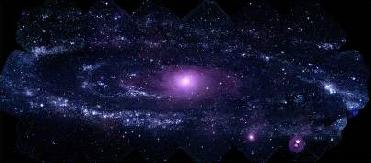
This mosaic of M31 merges 330 individual images taken by the Ultraviolet/Optical Telescope aboard Swift spacecraft. Image Credit: NASA
GREENBELT (BNS): Astronomers studying the M31 galaxy – the largest and closest spiral galaxy near our Milky Way – can now expect some interesting insights into star-forming processes in that cosmic body.
NASA’s Swift satellite has acquired highest-resolution view of the neighboring spiral galaxy ever attained in ultraviolet. The galaxy lies in the constellation Andromeda.
“Swift reveals about 20,000 ultraviolet sources in M31, especially hot, young stars and dense star clusters. Of particular importance is that we have covered the galaxy in three ultraviolet filters. That will let us study M31's star-formation processes in much greater detail than previously possible,” said Stefan Immler, a research scientist on the Swift team at NASA's Goddard Space Flight Centre in Greenbelt, Maryland.
M31, also known as the Andromeda Galaxy, is more than 220,000 light-years across and lies 2.5 million light-years away. On a clear, dark night, the galaxy is faintly visible as a misty patch to naked eye.
Swift's Ultraviolet/Optical Telescope has acquired 330 images of M31 between May and July 2008. These images shed light on the galaxy’s various facets. One among them is the striking difference between the galaxy's central bulge and its spiral arms.
“The bulge is smoother and redder because it's full of older and cooler stars,” Immler explained. “Very few new stars form here because most of the materials needed to make them have been depleted.”
Dense clusters of hot, young, blue stars sparkle beyond the central bulge. As in our own galaxy, M31's disk and spiral arms contain most of the gas and dust needed to produce new generations of stars. Star clusters are especially plentiful in an enormous ring about 150,000 light-years across, NASA said.
“Swift is surveying nearby galaxies like M31 so astronomers can better understand star- formation conditions and relate them to conditions in the distant galaxies where we see gamma-ray bursts occurring,” said Neil Gehrels, the mission's principal investigator at NASA Goddard.
Since its launch in 2005, Swift has detected over 400 gamma-ray bursts – massive, far-off explosions likely to be associated with formation of black holes.
 Next Article
Next Article











The Indian Air Force, in its flight trials evaluation report submitted before the Defence Ministry l..
view articleAn insight into the Medium Multi-Role Combat Aircraft competition...
view articleSky enthusiasts can now spot the International Space Station (ISS) commanded by Indian-American astr..
view article